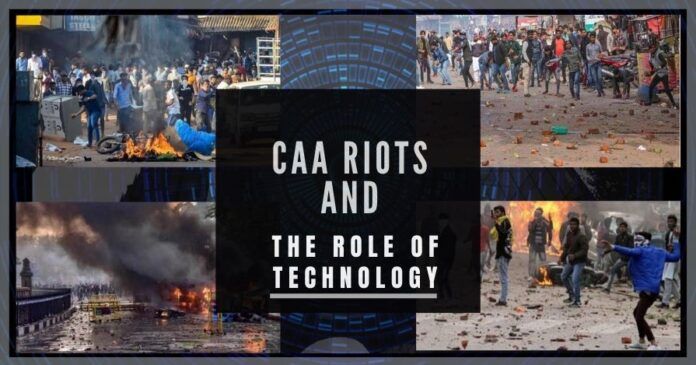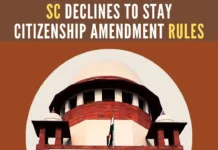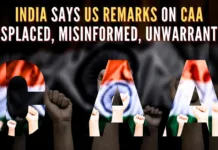
Keeping an eye on rioters, criminals, terrorists, and illegal aliens is a perfectly legitimate, and even desirable use of technology.
The riots and other disturbances loosely attributed to opposition to the Citizenship Amendment Act (CAA), it is increasingly clear, is about something else altogether: a concerted effort by the Congress, leftists and Islamists to overthrow the government.
The rioters figured out that video was their enemy, so, for instance, those in JNU started wearing masks, but the intrepid Aishe Ghosh was videotaped directing them, unmasked. Must have been an oversight.
As such, it is a matter of national interest, all politics aside. Can low-level insurgencies be contained? The answer is probably yes, certainly with a lot of technology and snooping.
At the outset, a disclaimer: I am nervous and skeptical about the privacy implications of technological surveillance and the Panopticon that is already out there. The Chinese experiment in ‘social credits’ is something that can go terribly wrong.
But there are legitimate uses of technology for national security.
First and foremost is the humble CCTV. The rioters figured out that video was their enemy, so, for instance, those in JNU started wearing masks, but the intrepid Aishe Ghosh was videotaped directing them, unmasked. Must have been an oversight.
Since we put so much faith in the video, the emergence of ‘deep fake’ technology is a threat. Realistic fake video will be here by 2021, but for the moment, surveillance cameras are good.
So much so that rioters in Mangalore were videographed breaking into private property (they were masked of course) to disable and turn video cameras away towards blank walls.
But masking themselves isn’t going to be enough for trouble-makers, because their smartphones will give them away. They carry with them pinpoint location information so that a seized phone (eg Google Maps data) is incontrovertible evidence of movements. This can be used against them.
There is apparently a significant flow of unrecorded funds through money laundering, and overseas funds coming in.
Intriguingly, law enforcement may soon identify people from their heartbeat patterns (as unique as fingerprints) even through their clothes. The Pentagon is developing an infrared laser that can identify you from as far away as 200 meters. See “The Pentagon’s New Laser-Based Tool Uses Your Heartbeat to Track You”[1]
Second, their social media posts can be used to create a gestalt about them. Even more interestingly, an application called Clearview can scrape their photos from social media to create a database for facial recognition, and it’s being used by various police forces in the US. See “The Secretive Company That Might End Privacy As We Know It”, New York Times, Jan 18th.[2]
Third, data analytics can discover patterns in financial data correlated to criminal or terrorist activity on the part of individuals and groups. The Aadhar unique id and the PAN number can be used to predict behavior based on transactions.
There is apparently a significant flow of unrecorded funds through money laundering, and overseas funds coming in. Sudden windfalls and unusual spending patterns by recipients of these illicit monies can also raise suspicions if machine intelligences are watching, as Sree Iyer suggests in his new book “Who painted my money white?”[3]
The uptake of fintech in India is quite high, as can be seen in the fact that even the local vegetable vendor now accepts BHIM or Paytm or Google Pay. This is one of the unsung benefits of demonetization, and it means you leave digital footprints everywhere.
EY suggests that the adoption of fintech in India is as high as in the much-lauded China, just about the highest in the world. See “Global Fintech Adoption Index 2019”[4]

Fourth, once blockchain is widely adopted, it becomes virtually impossible to erase your transactions. The days of proxy ownership of assets and of money laundering may be numbered.
Fifth, the newly-mandated Fastag for tolls also has the fringe benefit of tracking vehicles. In addition to toll payments, if smart lamp posts can be quietly kitted out with sensors, it will be possible to get a pretty good idea of the movements of suspicious vehicles, especially in certain areas. Just as criminals are tracked through their mobile phones, their vehicles can be subjected to surveillance by Fastag.
Several police forces are using techniques reminiscent of ‘pre-crime’ in the film Minority Report to predict localities where crimes are likely to occur. (The film used psychics, today it is algorithms, big data, and machine learning).
Indian investigators should use these techniques to identify potential crime and terrorism hotspots as well as potential perpetrators and keep them under enhanced surveillance.
As we move towards Smart Cities with ubiquitous connectivity and IoT sensors embedded all over the place, security officials will have a bonanza of data about bad actors.
While I reiterate significant concerns about privacy (what if a malign government uses this pinpoint targeting to harass law-abiding citizens and residents?), I think using it to keep an eye on rioters, criminals, terrorists, and illegal aliens is a perfectly legitimate, and even desirable use of technology.
Rioters beware. Big brother is watching you.
Note:
1. The views expressed here are those of the author and do not necessarily represent or reflect the views of PGurus.
References:
[1] The Pentagon’s New Laser-Based Tool Uses Your Heartbeat to Track You – Jul 11, 2019, Singularityhub.com
[2] The Secretive Company That Might End Privacy as We Know It – Jan 18, 2020, Nytimes.com
[3] Who painted my money white: When greed drives everything else and everything has a price (Money Trilogy Book 1) – Amazon.in
[4] Global FinTech Adoption Index 2019 As FinTech becomes the norm, you need to stand out from the crowd – Fintechauscensus.ey.com
- The lament of the Kulaks - February 11, 2021
- Animal rights: violations everywhere, but only India is targeted by PETA busybodies - November 24, 2020
- CAA Riots and the Role of Technology - February 2, 2020










